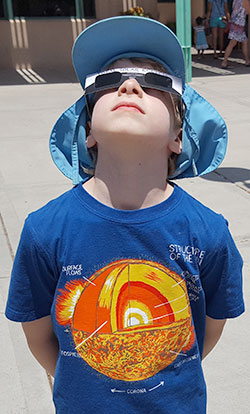
Ask Timmy
Got an astronomy question? Timmy loves to answer questions. Send your question to:
Recently asked questions
- What is light made of?
Electromagnetic energy; that is, energy that travels in the form of a wave. Energized electrons release a specific amount of energy called a Photon. Visible light (ROY G BIV) is made up of many wavelengths of this energy. - How many degrees in F are there?
The scale starts at -459.67degrees (absolute zero) but electromagnetic energy needs for electrons to move, so there is no “light” at this temperature. There is no real end to the scale, but the highest temperature ever recorded is 7.2 trillion degrees. The hottest star (a Blue Hypergiant) is estimated to be around 180,000 degrees at the surface, with most being around 1500 degrees to 90,000 degrees. Our sun has a hot core (around 28 million degrees), a cooler surface (around 10,000 degrees) with the Corona or outer atmosphere estimated at around 9 million degrees. - How is the sun [and most stars] formed?
Dust, gas and plasma in the universe collects or concentrates in what is called an accretion disc. This disc, as it gains mass, starts to spin and contracts. As the contraction continues, pressure and temperature increases to a point that Hydrogen atoms star to collide and “fuse” into Helium…the sun, a star, is/was born. - At what rate is the sun growing?
Two part answer. The core is actually getting smaller, very slowly; while the outer atmosphere is expanding (not uniformly). Using equations like E=m(Cexp2), the sun has lost about 0.03% of its original mass. The process will speed up as it approaches the Red Giant phase (as H is concerted in He). At this point, the sun’s outer atmosphere will be between Venus and the Earth (right now it is around 94 millions miles away). At the end of the Red Giant phase, the Corona will be between Mars and Jupiter; but the Core (now a White Dwarf) will be about the size of Mercury. - What are solar flairs?
Electromagnetic “eruptions” from a sun spot or magnetic storm under/on the Photosphere (or surface of the sun). The electromagnetic energy drives plasma off the surface into space…sometimes in our direction. - Could there be more than 1 sun? If so, what would happen?
Yes, most star systems (solar systems) have more than one star. The result really depends on what type of star(s) is/are involved and the orbital locations of the star(s). If the star orbit each other (eclipsing binaries), then the inner planets would be really hot but the outer planets would receive more energy. If the stars where spaced more evenly, then each local planet group would have different environments. - How do you collect ultraviolet light and put it in a flashlight?
The bulb in the flashlight gives off (emits) ultraviolet wavelengths. Electrons in any material if given enough energy can produce ultraviolet light. - When the sun explodes, would the planets far from the sun explode or just go off into space?
Our sun is too small to explode. It will expand and turn into a planetary nebula or stellar cloud. The planets will pretty much stay in their same orbits until the sun fades away. As the sun uses up all of its fuel, then the planet will drift away into space. Stars at least 2 to 3 times the mass sun can explode, but the process is fairly complicated and we need to do more research to really understand how this happens. - In the revolution of the planets, is the sun in orbit around something in space?
Planets orbit or revolve around a star (suns). The time it takes is called “a year”. Stars revolve around the center of the galaxy; stars sometime orbit around the center of the galaxy together in a cluster. Most galaxies have a “Black Hole” at their center. It is estimated that it takes our sun 250 million Earth years to make one orbit around the center of our Milky Way galaxy. That would be one Solar year. - What is an atom made of?
Atoms are composed of Proton (+) and Neutrons (o); atoms are the smallest “recognizable” form of matter. Carbon atoms all have 6 Protons (the number of Neutrons can vary). Protons and Neutrons are composed of particles called “subatomic particles” but lose their atomic identity. Subatomic particles of Carbon atoms look and act like subatomic particles of any other atom. - Is there anything orbiting the atom?
Electrons (-) orbit the nucleus or center of the atom where the Protons and Neutrons are located. Their orbits have a specific geometry or directions or positions in space depending on the amount of energy available. When the electrons change their position they give off wavelengths of light which we see as “colors”. High energy, short wavelengths we see as ultraviolet; Low energy, long wavelengths we see as red. - What is the most common light relating to our sun?
That has many answers. Yellow is the color we see when we look at our sun. So we could say the frequency of light that we see everyday is in the Yellow portion of the spectrum. But as we learned during our visit, the sun produces ALL (except for gamma radiation) “lights” of the electromagnetic spectrum. So we could say, the RAINBOW is the most common light from our sun, but we need instruments to see them. - Why did you choose to study space?
The Earth is a member of a “universal” family. The more we learn and understand about that universe, the better we can understand the natural processes of our planet and solar system.
